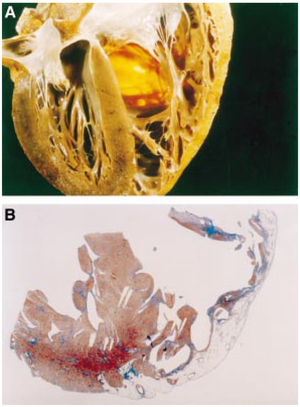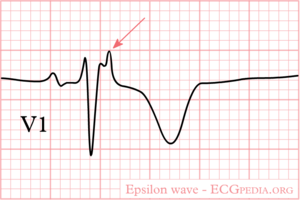Arrhythmogenic Right Ventricular Cardiomyopathy
| Author(s) | J.S.S.G. de Jong, MD | |
| Moderator | J.S.S.G. de Jong, MD | |
| Supervisor | ||
| some notes about authorship | ||
What is ARVC?

Aritmogene Rechter Ventrikel Dysplasie, ARVD of ARVC (cardiomyopathie) is een ziekte dat gekenmerkt wordt door vervetting en fibrosering van het hart. Met name de rechter ventrikel (apex), de rechter ventrikel uitstroombaan en de rechter ventrikel vrije wand , net onder de triscupidalis kleppen zijn het meest aangedaan. Meestal is de rechter ventrikel aangedaan, maar de linker kamer kan ook betrokken zijn.
Door de vervetting en fibrosering ontstaan er makkelijk kamerritmestoornissen, die zich kunnen uiten als palpitaties, duizeligheid, syncope (flauwvallen) of plotselinge dood. Op latere leeftijd kan ook rechterkamerfalen optreden door een verminderde pompkracht.
De diagnose wordt gesteld op basis van major en minor criteria van de European Society of Cardiology.[2]
ARVD is een progressieve ziekte. De incidentie wordt geschat op 1:3.000-1:10.000. De ziekte presenteert zich vooral in de tienerleeftijd. Hoewel de ziekte vaker bij atleten wordt gezien, wordt het echter niet door sport veroorzaakt. ARVD kan familiair voorkomen; er zijn inmiddels 9 chromosomale afwijkingen gevonden in verschillende families. De ziekte lijkt autosomaal dominant over te erven. Hiernaast is er ook tenminste één duidelijk onderkende variant van ARVD (De ziekte van Naxos, naar het Griekse eiland waar een familie gevonden is met deze variant) die met een autosomaal recessief patroon overerft.
Diagnose
De diagnose ARVD is niet makkelijk te stellen, behalve bij obductie. Op het ECG zijn soms een aantal karakteristieke afwijkingen te zien, namelijk:
- Epsilon golven
- Verlengde QRS duur (>110ms) in de precordiale afleidingen (V1–V3)
- Late potentialen op een signal averaged ECG
The European Society of Cardiology has created a list of diagnositc criteria for the diagnosis of ARVC.
| Major diagnostic criteria for Aritmogenic Right Ventricular Cardiomyopathy[2] |
|---|
|
| Diagnostic criteria that can be diagnosed on the ECG |
|
Behandeling
De therapie bestaat vooralsnog uit preventie van complicaties.[3]
- Medicatie: anti-arritmetica: Amiodarone, Sotalol; verder ace-remmers ter voorkoming van remodeling van het hart.
- Preventieve ICD plaatsing bij patienten die ondanks optimale medicamenteuze behandeling een sustained ventriculaire tachycardie of ventrikelfibrilleren ontwikkelen. Ook komen in aanmerking voor ICD: patiënten met een uitgebreid aangedaan hart waarbij bijvoorbeeld ook de linker kamer aangedaan is, patiënten met meerdere familie-leden die overleden zijn aan ARVD, patiënten die ondanks medicatie een syncope hebben waarbij ventrikelfibrilleren of ventrikeltachycardie niet kan worden uitgesloten.
- Ablatie kan toegepast worden bij patienten met recidiverende ventrikeltachycardiën ondanks medicamenteuze behandeling.
Externe links
Referenties
- Corrado D, Basso C, and Thiene G. Arrhythmogenic right ventricular cardiomyopathy: diagnosis, prognosis, and treatment. Heart. 2000 May;83(5):588-95. DOI:10.1136/heart.83.5.588 |
- McKenna WJ, Thiene G, Nava A, Fontaliran F, Blomstrom-Lundqvist C, Fontaine G, and Camerini F. Diagnosis of arrhythmogenic right ventricular dysplasia/cardiomyopathy. Task Force of the Working Group Myocardial and Pericardial Disease of the European Society of Cardiology and of the Scientific Council on Cardiomyopathies of the International Society and Federation of Cardiology. Br Heart J. 1994 Mar;71(3):215-8. DOI:10.1136/hrt.71.3.215 |
- European Heart Rhythm Association, Heart Rhythm Society, Zipes DP, Camm AJ, Borggrefe M, Buxton AE, Chaitman B, Fromer M, Gregoratos G, Klein G, Moss AJ, Myerburg RJ, Priori SG, Quinones MA, Roden DM, Silka MJ, Tracy C, Smith SC Jr, Jacobs AK, Adams CD, Antman EM, Anderson JL, Hunt SA, Halperin JL, Nishimura R, Ornato JP, Page RL, Riegel B, Priori SG, Blanc JJ, Budaj A, Camm AJ, Dean V, Deckers JW, Despres C, Dickstein K, Lekakis J, McGregor K, Metra M, Morais J, Osterspey A, Tamargo JL, Zamorano JL, American College of Cardiology, American Heart Association Task Force, and European Society of Cardiology Committee for Practice Guidelines. ACC/AHA/ESC 2006 guidelines for management of patients with ventricular arrhythmias and the prevention of sudden cardiac death: a report of the American College of Cardiology/American Heart Association Task Force and the European Society of Cardiology Committee for Practice Guidelines (Writing Committee to Develop Guidelines for Management of Patients With Ventricular Arrhythmias and the Prevention of Sudden Cardiac Death). J Am Coll Cardiol. 2006 Sep 5;48(5):e247-346. DOI:10.1016/j.jacc.2006.07.010 |
